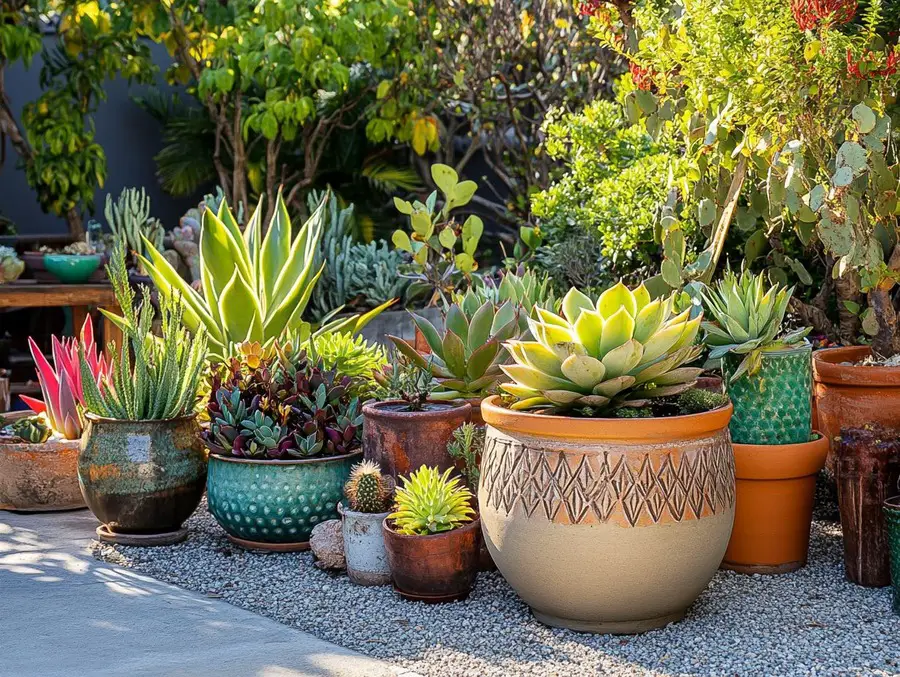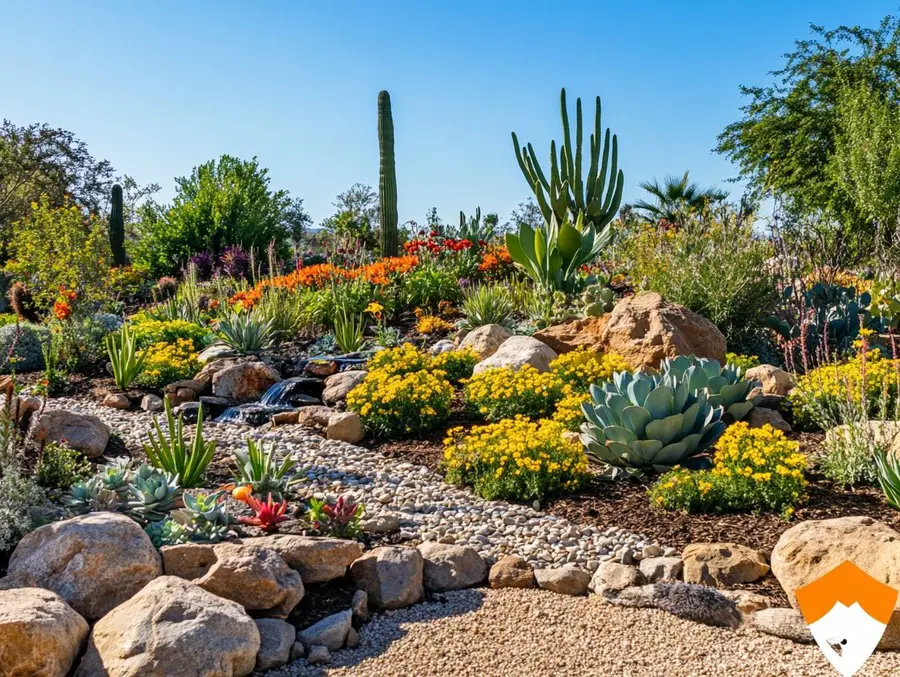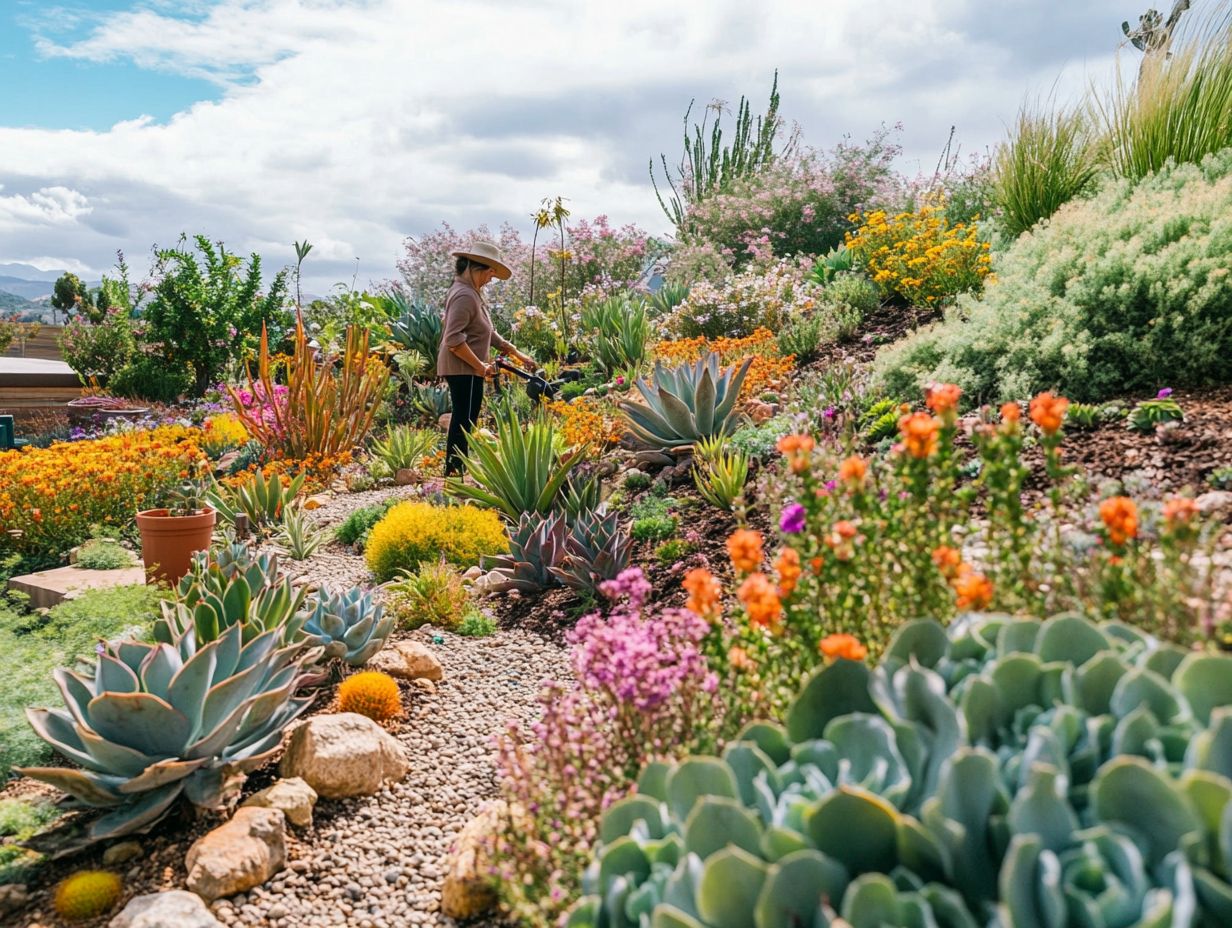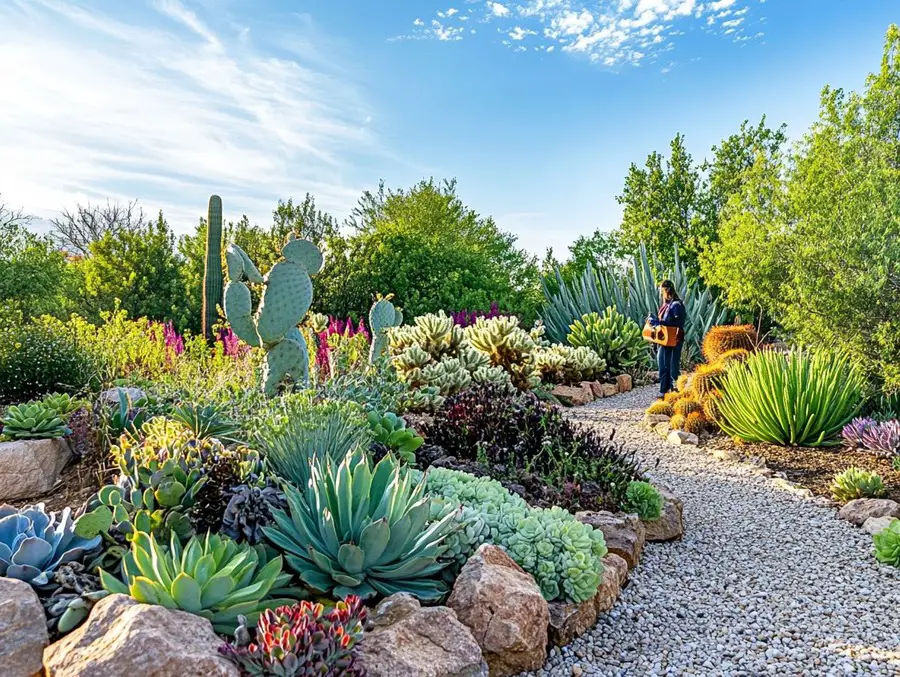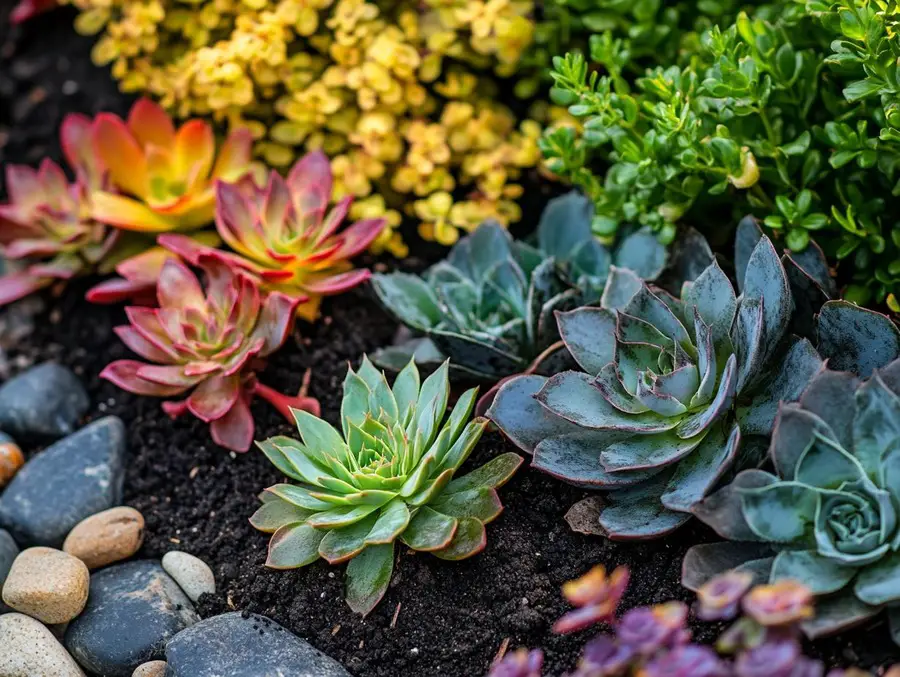We use affiliate links. If you purchase something using one of these links, we may receive compensation or commission.
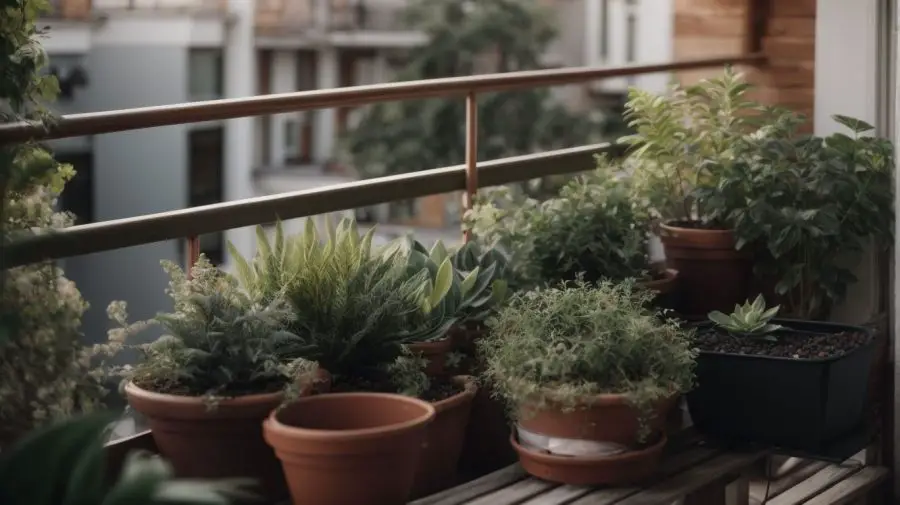
Discover the best plants for an apartment balcony! Explore low-maintenance, space-savvy options for adding a lush touch to your urban oasis.
Best Plants for an Apartment Balcony
Key Takeaways:
- The best plants for an apartment balcony include versatile, low-maintenance options like succulents, herbs, and small shrubs.
- Ideal for limited space, they thrive with minimal care, adding beauty and tranquility to your urban outdoor area.
Transform your urban space into a green haven with the best plants for an apartment balcony. Whether it’s a splash of color or a hint of nature you’re after, our guide will help you create a serene, plant-filled retreat amidst the city hustle.
Best Plants for an Apartment Balcony
Apartment living doesn’t mean you have to forgo the joys of gardening.
In fact, balcony gardening can be a wonderful way to bring nature into your urban space.
From the benefits of balcony gardening to considerations specific to apartment living, this article will guide you through everything you need to know to create a thriving green oasis right outside your door.
Whether your balcony receives full sun, partial shade, or shade, we’ll explore the best plants that will thrive in your specific conditions, including easy-to-grow herbs and flowers.
We’ll also provide valuable insights on maintaining balcony plants, including watering and care tips, as well as seasonal considerations.
By the end of this article, you’ll be equipped with the knowledge and inspiration to create a flourishing balcony garden that enhances your living space and brings a touch of nature to your urban lifestyle.
Let’s get started on your balcony gardening journey.
Key Takeaways: What Is Covered
- Choosing plants that thrive in your balcony’s sun exposure – full sun, partial shade, or shade.
- Consider easy-to-grow plants like herbs, roses, and pansies for low-maintenance balcony gardening.
- Regular watering and seasonal care are important for maintaining healthy balcony plants.
Introduction to Balcony Gardening
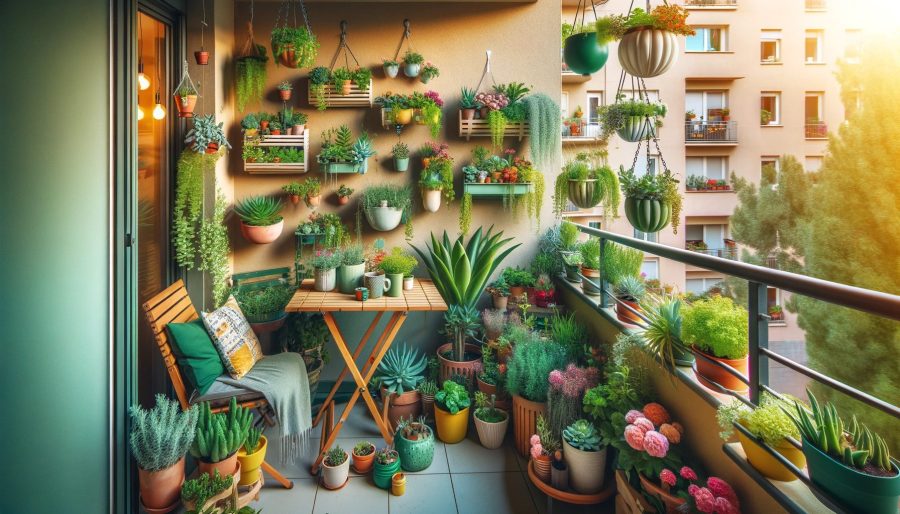
Balcony gardening is the art of growing plants and creating a garden in a limited space such as a balcony, allowing individuals to enjoy the beauty of nature within their own living environment.
One of the key benefits of balcony gardening is the ability to cultivate a variety of plants in a confined urban setting.
From colorful flowers like petunias and geraniums to aromatic herbs such as basil and mint, balcony gardens offer a wide range of plant varieties to choose from.
Balcony gardening provides an opportunity for individuals to actively engage with nature, fostering a sense of tranquility and well-being.
Benefits of Balcony Gardening
Embarking on balcony gardening offers numerous benefits, including the ability to cultivate beautiful plants, the opportunity to create an oasis in a confined space, and the joy of nurturing greenery in an urban setting.
It’s amazing how balcony gardening has become a popular trend, especially in urban areas where outdoor spaces are limited.
One of the greatest advantages is the sheer accessibility – just step outside and immerse yourself in a natural haven.
The therapeutic benefits of surrounding oneself with plants are well-documented, from reducing stress and anxiety to improving overall well-being.
Balcony gardening allows individuals to develop a deeper connection with nature, bringing a sense of tranquility and rejuvenation to their living spaces.
Not only does it beautify the surroundings, but also creates a more eco-friendly environment, contributing to a greener urban landscape.
The aesthetic value added by a lush, verdant balcony garden transforms the visual appeal of residential spaces, often becoming a conversation starter and a source of pride for homeowners.
Considerations for Apartment Balcony Gardening
Apartment balcony gardening requires careful consideration of factors such as available space, sunlight exposure, and the suitability of plant varieties that can thrive in contained environments.
When dealing with space constraints, it is essential to opt for compact and versatile plants that can flourish in smaller areas, such as herbs, dwarf varieties of vegetables, and flowers like petunias and marigolds.
Assessing the sunlight exposure is crucial for selecting the right plants, as some may thrive in shade while others require plenty of direct sunlight.
Container gardening techniques, like hanging baskets, window boxes, and vertical planters, can optimize space and allow for the cultivation of a wide array of plants.
Plants That Thrive in Full Sun
Certain plants flourish in full sun conditions, making them ideal choices for balcony gardening in areas with ample sunlight and warmth.
Lavender is a classic sun-loving plant known for its fragrant foliage and beautiful blooms. It thrives in well-drained soil and requires minimal maintenance, making it perfect for busy gardeners.
Hydrangeas are another stunning option, with their large, colorful flowers that add a pop of color to any sunny spot. They need regular water and occasional fertilization to keep blooming throughout the season.
Jasmine, known for its intoxicating scent, is a versatile full-sun plant that can be grown as a vine or a shrub.
It needs ample sunlight and well-drained soil to thrive and blooms best when provided with proper care.
Strawberries are a delightful addition to a sun-drenched garden, producing sweet, juicy fruits when given plenty of sunlight and regular watering.
With a bit of attention, these sun-loving plants can turn your balcony into a vibrant, flourishing oasis.
Hydrangeas
Hydrangeas, with their vibrant blooms and lush foliage, are popular choices for balcony gardening, especially in locations that receive abundant sunlight.
Their versatility makes them suitable for various balcony sizes and designs. These exquisite plants require well-draining, moist soil and benefit from regular watering, especially during the hot summer months.
With the right fertilization and pruning, they can thrive and provide a stunning display of color and texture throughout the season, enhancing the visual appeal of balconies.
Their ability to change color based on soil pH adds an intriguing dynamic to balcony landscapes.
Jasmine
Jasmine, known for its fragrant flowers and climbing nature, thrives in full sun and is a delightful addition to balcony gardens, infusing the air with its sweet scent.
Its delicate white or yellow blossoms exude a captivating aroma, creating a serene and welcoming ambiance.
The vining habit of jasmine makes it an ideal space-saving addition to small balconies, as it can be trained to grow vertically, providing a beautiful natural screen or privacy barrier.
With regular watering and well-draining soil, jasmine can thrive in a balcony environment, enhancing the outdoor living experience with its beauty and fragrance.
Strawberries
Strawberries are well-suited for balcony gardening in full sun, offering the joy of harvesting fresh, flavorful berries within the confines of urban living spaces.
Cultivating strawberries in balcony gardens requires attention to their specific growth requirements.
Choose a container with good drainage to prevent waterlogging, as strawberries prefer well-drained soil.
Ensure they receive at least 6-8 hours of sunlight daily, and consider using a trellis or hanging basket to maximize space.
Regularly checking soil moisture and providing proper fertilization can promote healthy growth and abundant fruiting.
The reward of nurturing these delightful fruits right at home makes the effort worthwhile and offers a fulfilling connection to nature.
Lavender
Lavender, renowned for its aromatic blooms and resilience in sunny conditions, thrives in balcony gardens, bringing fragrance and visual allure to outdoor spaces.
Its ability to flourish in containers makes it an ideal choice for balconies, as it adds a touch of elegance and tranquility to these urban oases.
The soothing scent of lavender not only creates a peaceful ambiance but also acts as a natural insect repellent, making it a practical and beautiful addition to any balcony garden.
Plants for Partial Shade or Shade
In areas with partial shade or complete shade, several plant varieties thrive and enhance the aesthetic appeal of balcony gardens, offering options for greening shaded spaces.
Plants that are well-suited for partial shade or complete shade include ferns, hostas, and heucheras.
These plants have adapted to low-light conditions and require minimal sunlight to thrive.
Their lush foliage and vibrant colors can add a touch of elegance and tranquility to shaded balcony environments.
To care for these plants, it’s essential to provide well-draining soil, regular watering, and occasional fertilization.
Incorporating ornamental grasses like Japanese forest grass or Hakone grass can introduce unique texture and movement to shaded areas, creating a dynamic visual impact.
Lobelia
Lobelia, with its delicate flowers and preference for partial shade, thrives in balcony gardens, adding a touch of elegance to shaded outdoor spaces.
This perennial plant is known for its trailing growth habit, making it well-suited for hanging baskets and containers.
Its vibrant hues of blue, purple, white, and pink create a striking contrast with the surrounding greenery.
Lobelia’s moderate watering needs and low maintenance requirements make it a popular choice for urban gardeners seeking a pop of color on their balconies.
With proper care, including well-drained soil and regular fertilization, this shade-tolerant beauty can continue to bloom throughout the growing season.
Fuchsia
Fuchsia, known for its vibrant blooms and suitability for shaded areas, thrives in balcony gardens, infusing shaded spaces with its colorful floral display.
Its pendulous, bell-shaped flowers in shades of pink, purple, and white add a touch of elegance to balconies, attracting pollinators and mesmerizing observers.
When cultivating fuchsia in shaded balcony settings, it’s essential to ensure well-draining soil, regular watering, and protection from harsh midday sun.
This shade-loving plant not only brightens up the balcony but also complements the surrounding foliage, creating a picturesque and charming ambiance.
With the right care and attention, fuchsia can flourish and bring enchanting beauty to even the most shaded balcony spaces.
Sweet Alyssum
Sweet alyssum, with its delicate clusters of flowers and preference for shade, thrives in balcony gardens, creating a charming ambiance in shaded outdoor settings.
These petite, low-growing plants are perfect for adding a touch of elegance to balconies with limited direct sunlight.
Their vibrant hues, including shades of white, pink, and purple, contrast beautifully against the rich green backdrop of foliage.
When cared for properly, sweet alyssum can form a dense carpet of blossoms, becoming a visual focal point in the balcony space.
One of the key appeals of sweet alyssum is its fragrance.
The sweet, honey-like scent that emanates from the flowers adds an extra sensory dimension to the outdoor living area, making it a delight for anyone spending time on the balcony.
New Guinea Impatiens
New Guinea impatiens, known for their vibrant blooms and tolerance for shaded conditions, thrive in balcony gardens, bringing a burst of color to shaded outdoor spaces.
These versatile plants are a perfect solution for balconies that receive limited direct sunlight, as they are well-suited to thrive in shaded conditions.
Their lush green foliage and vibrant flowers create a visually stunning display, adding a touch of elegance to any balcony space.
With the right care, including regular watering and occasional feeding, New Guinea impatiens can flourish in containers, hanging baskets, or raised beds, offering a wide range of options for balcony gardeners.
Easy-to-Grow Plants for Balcony Gardening
Selecting easy-to-grow plants for balcony gardening simplifies the cultivation process, allowing individuals to enjoy the satisfaction of nurturing resilient and low-maintenance plant varieties.
One popular option for balcony gardening is the peace lily. This plant thrives in low light conditions, making it ideal for apartments and condos with limited natural light.
Another excellent choice is the snake plant, known for its air-purifying qualities and ability to withstand neglect.
Additionally, herbs like basil, mint, and rosemary are versatile, and aromatic, and require minimal care, making them perfect for beginners.
Lastly, succulents such as aloe vera or echeveria are incredibly adaptable and add a touch of natural beauty to any balcony space.
Herbs
Herbs, with their versatility and suitability for container gardening, are excellent choices for balcony gardens, providing a convenient source of fresh flavors within arm’s reach.
They thrive in limited space and are well-suited to growing in pots or containers, making them perfect for balconies.
The culinary potential of herbs, with options like basil, rosemary, and thyme, allows for easy access to a variety of cooking ingredients right outside the kitchen.
With minimal care requirements and the ability to flourish with adequate sunlight and water, herbs are practical and low-maintenance additions to any balcony garden.
They also offer aesthetic appeal, with their aromatic leaves and occasional blooms, enhancing the overall ambiance of the outdoor space.
Rose
Roses, with their timeless beauty and adaptability to container growth, thrive in balcony gardens, adding an element of romance and elegance to outdoor living spaces.
These delicate blooms not only bring a splash of color to the urban landscape but also fill the air with their enchanting fragrance.
The charm of roses as balcony plants extends beyond their visual appeal, as they symbolize love, passion, and beauty, creating a picturesque ambiance for relaxation and contemplation.
With proper care and attention, roses can flourish in containers, making them a popular choice for balcony gardening enthusiasts.
Their versatility in adapting to different container sizes, soil types, and climatic conditions makes them an ideal choice for urban gardeners with limited outdoor space.
Whether you opt for miniature varieties or cascading climbers, roses offer a myriad of options to tailor your balcony garden to your unique style and preference.
Mandevilla
Mandevilla, prized for its vibrant blooms and climbing nature, thrives in balcony gardens, creating a stunning display of colors and greenery in compact outdoor settings.
With its long, twining stems, the mandevilla can gracefully weave its way around railings and trellises, adding vertical interest to any space.
The plant requires regular watering and well-draining soil, and it flourishes in full sun, making it an ideal choice for balconies with ample sunlight.
Its glossy dark green leaves complement the profusion of blooms in shades of pink, red, or white, adding a touch of elegance to the urban landscape.
Pansies and Violas
Pansies and violas, with their charming blooms and adaptability to container growth, thrive in balcony gardens, enlivening outdoor spaces with their colorful and cheerful floral displays.
These delicate yet resilient flowers are perfect choices for balcony gardening enthusiasts. Their petite size allows them to flourish in small spaces, enhancing the visual appeal of balconies with their vibrant hues of purple, yellow, white, and blue.
The ability of pansies and violas to thrive in containers further adds to their appeal, making them ideal selections for those embracing the art of container gardening.
Maintaining Balcony Plants
Effective maintenance is vital for the well-being of balcony plants, encompassing essential practices such as proper watering, attentive care, and consideration of seasonal factors to ensure optimal plant health and vitality.
Regarding watering techniques, a balance must be struck between providing adequate moisture without over-saturating the soil.
Most balcony plants benefit from a thorough watering session when the top inch of soil feels dry, ensuring that excess water drains from the pots to avoid waterlogged roots.
Other care considerations include providing the appropriate sunlight exposure for the specific plant species, regular soil checks for pests or diseases, and periodic fertilization to replenish essential nutrients.
These steps contribute significantly to the overall well-being of balcony plants.
Seasonal adjustments play a crucial role in ensuring the health of balcony plants, with changes in temperature and daylight affecting their growth patterns.
For instance, in colder months, insulating plants from frost and providing adequate warmth becomes essential, while during warmer seasons, it’s important to shield them from excessive heat and dry air.
Watering and Care Tips
Balcony plant care involves diligent watering practices, regular inspection for pests or diseases, and adjustments based on seasonal variations to ensure the thriving condition of the greenery.
Self-watering planters can take some of the burden out of regular watering. They will even out watering by using capillary action.
Regarding watering balcony plants, it’s crucial to strike the right balance.
Overwatering can lead to root rot, while underwatering can cause wilting and stunted growth.
The general rule of thumb is to water when the top inch of the soil feels dry, but this can vary depending on the specific plant species and environmental factors.
To prevent common pests such as aphids, spider mites, and whiteflies, routine monitoring is essential.
Natural remedies like insecticidal soap or neem oil sprays or introducing beneficial insects can help control infestations without harming the plants.
As for diseases, maintaining proper air circulation and promptly removing any infected leaves can mitigate their spread.
Seasonal changes significantly impact the care routine. In warmer months, plants generally require more water, and it’s essential to shield them from excessive heat to prevent sunburn.
In winter, reducing watering frequency and protecting plants from frost or cold drafts is crucial.
Adjusting fertilization and pruning schedules in line with seasonal shifts can support the plants’ overall health.
Seasonal Considerations
Seasonal changes necessitate adjustments in balcony plant care, including considerations for temperature fluctuations, climate suitability, and the adaptation of care practices to align with the needs of plants during different times of the year.
The impact of seasonal changes on balcony plant care is significant, as temperature variations directly affect the growth and health of plants.
During winter, low temperatures can lead to frost damage, while in summer, excessive heat can cause dehydration and stress.
Concurrently, adjusting the watering schedule according to seasonal humidity levels and temperatures becomes crucial for plant survival.
Conclusion and Next Steps
In conclusion, balcony gardening offers a delightful opportunity to cultivate a green sanctuary in limited spaces, providing a rewarding experience for plant enthusiasts, with the next steps involving the selection of suitable plant varieties and the initiation of the balcony gardening journey.
Balcony gardening is not only a space-efficient way to bring nature into urban living but also presents a canvas for personal creativity and relaxation.
The appeal of balcony gardening lies in the ability to transform a small outdoor area into a flourishing oasis, filled with color, scent, and the soothing presence of greenery.
As individuals embark on this journey, the selection of suitable plant varieties becomes pivotal.
Understanding the balcony’s microclimate, sunlight exposure, and available space can guide the choice of plants that thrive in these conditions.
The next step involves initiating the balcony gardening journey.
This includes organizing the balcony space, determining the type of containers or planters needed, and preparing the soil or growing medium suitable for the selected plant varieties.
Read more: Balcony Gardening: Comprehensive Guide
Frequently Asked Questions
Q. What are the best plants for an apartment balcony?
A. Some of the best plants for an apartment balcony include succulents, herbs, and small shrubs. These plants are low maintenance and can thrive in limited space and sunlight.
Q. Do I need a lot of space for plants on my apartment balcony?
A. No, you do not need a lot of space for plants on your apartment balcony.
Many plants, such as hanging baskets and vertical gardens, are specifically designed for small spaces.
You can also use shelves and wall-mounted planters to make the most of your space.
Q. What are some low-maintenance plant options for an apartment balcony?
A. Succulents, cacti, and air plants are all low-maintenance options for an apartment balcony.
They require minimal watering and can thrive in indirect sunlight.
Herbs and some small shrubs, such as lavender, are also low maintenance and can add a touch of greenery to your balcony.
Q. Can I grow a vegetable garden on my apartment balcony?
A. Yes, you can grow a small vegetable garden on your apartment balcony.
Some vegetables that do well in containers include tomatoes, peppers, carrots, and leafy greens.
Just make sure to choose plants that are suitable for the amount of sunlight and space you have available.
Q. How do I protect the plants on my apartment balcony from strong winds?
A. You can protect your plants from strong winds by using windbreaks, such as trellises or fabric barriers.
You can also choose sturdier plants that can withstand strong winds, like bamboo or ornamental grasses.
Additionally, regularly trimming and pruning your plants can make them more resistant to strong winds.
Q. What are some creative ways to incorporate plants on my apartment balcony?
A. There are many creative ways to incorporate plants on your apartment balcony.
You can use hanging baskets, vertical gardens, and wall-mounted planters to make the most of your space.
You can also repurpose old containers, such as mason jars or tin cans, to add a unique touch to your balcony garden.
Related Content
Visit my Amazon Influencer Page for videos and gardening products Grow Your Own Garden

























